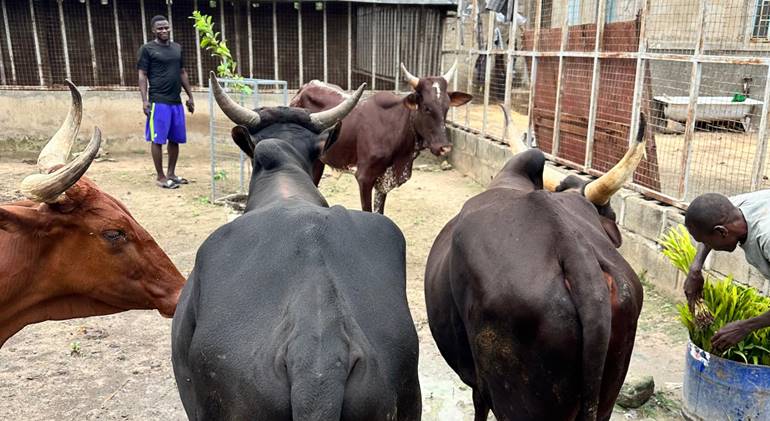Background
Northern Nigeria, a region with a predominantly agrarian economy, is increasingly feeling the devastating effects of climate change. As temperature rises, rainfall patterns shift, and desertification spreads, agribusinesses in the region face unprecedented challenges. These climate disruptions affect agricultural productivity, food security, and economic stability, threatening millions who depend on farming.
This blog post integrates recent research from FAO, World Bank, Nigerian agricultural agencies, and scholarly sources, offering a data-driven perspective on the impact of climate change on agribusiness in Northern Nigeria.
1. Changing Rainfall Patterns and Water Scarcity
One of the most pressing effects of climate change in Northern Nigeria is the increasing unpredictability of rainfall. A study by Ubokudom and Onyeaghala (2024) found that rainfall patterns in the region have become more erratic over the last three decades, with longer dry spells and shorter rainy seasons disrupting traditional farming.
Additionally, Mahmud (2023) noted that over 60% of farmers in Northern Nigeria now experience severe water shortages due to lower groundwater levels and the shrinking of major rivers. The Nigerian Meteorological Agency (NiMet) also reported a 30% decrease in annual precipitation in key agricultural zones like Kano, Katsina, and Sokoto.
Impact on Agribusiness:
- Crop failure rates have increased by 20-30% in rainfed farms (Mahmud, 2023).
- Irrigation-dependent farming is declining as water sources like Lake Chad shrink (FAO, 2022).
- Agricultural investment has dropped by 15% in drought-prone regions (World Bank, 2023).
2. Increased Incidence of Pests and Diseases
Warmer temperatures have created ideal conditions for pests and diseases to thrive. A FAO-Nigeria (2022) report found that:
- The fall armyworm, which destroys maize crops, has spread to 80% of Northern Nigerian farms.
- Tsetse fly and tick infestations have risen by 40%, leading to higher cattle mortality in livestock farms.
Additionally, Ikuemonisan (2024) noted that farmers are now spending 35% more on pesticides and veterinary treatments, leading to higher production costs and lower profit margins for agribusinesses.
Impact on Agribusiness:
- Losses of ₦120 billion ($150M) annually due to crop pest invasions (World Bank, 2023).
- Declining dairy and meat production due to livestock diseases (FAO, 2022).
- Increased cost of pest control is driving smallholder farmers out of business (Restrepo et al., 2023).
3. Desertification and Land Degradation
Desertification remains a serious threat in Northern Nigeria, with Mahmud (2023) estimating that 400,000 hectares of farmland are lost annually to land degradation.
Key Findings:
- The Sahara Desert is expanding southward at 0.6 km per year, consuming farmland in Kano, Katsina, and Borno (FAO, 2023).
- Over 60% of smallholder farmers in Northern Nigeria have reported loss of fertile land (Nwosu, 2022).
- Government reforestation projects remain underfunded, covering only 5% of affected land (FAO-Nigeria, 2023).
Impact on Agribusiness:
- Higher costs for soil fertility management (fertilizers, irrigation).
- Increased rural-to-urban migration leading to loss of farm labor.
- Reduced agribusiness investments as land degradation worsens.
4. Food Security and Economic Disruptions
With declining agricultural yields, food security is under threat in Northern Nigeria. According to Ngukimbin and Shinku (2021), food production has declined by 25% in Northern states, leading to rising prices of staple crops like maize, millet, and sorghum.
A World Bank (2023) report confirmed that food inflation in Nigeria hit a 17-year high, driven by climate-induced supply shortages.
Impact on Agribusiness:
- Rising food prices make it harder for consumers to afford basic meals.
- Agro-processing companies suffer raw material shortages, affecting industries like flour milling, beer brewing, and animal feed production.
- Increased malnutrition and food insecurity put pressure on humanitarian agencies.
5. Conflicts Between Farmers and Herders
As land and water resources dwindle, conflicts between farmers and nomadic herders have intensified. A FAO-Nigeria (2023) report revealed that:
- 80% of Northern Nigerian agrarian communities have experienced conflicts over land.
- These conflicts have led to the destruction of farmland worth over ₦1 trillion ($1.2B) since 2018.
- Over 2 million farmers and herders have been displaced in the last 5 years.
Impact on Agribusiness:
- Displacement of farmers leads to abandoned farmlands.
- Destruction of crops and livestock disrupts agribusiness supply chains.
- Security concerns discourage foreign and domestic agribusiness investments.
6. Solutions and Adaptation Strategies
While the challenges are significant, there are solutions to help agribusinesses adapt:
1. Climate-Smart Agriculture (CSA):
- Drought-resistant crops: Adoption of climate-resilient maize, millet, and cowpea.
- Efficient irrigation: Drip irrigation and water conservation systems (FAO, 2022).
- Agroforestry: Combining trees with crops to prevent soil erosion (CGIAR, 2023).
2. Early Warning Systems and Weather Forecasting:
- Digital advisory platforms provide farmers with real-time climate updates (Restrepo et al., 2023).
- AI-powered predictions improve agricultural decision-making (FAO, 2022).
3. Sustainable Land Management Practices:
- Soil conservation, crop rotation, and organic farming to restore soil fertility.
- Expansion of the Great Green Wall initiative to curb desertification (FAO, 2023).
4. Investment in Renewable Energy for Agribusinesses:
- Solar-powered irrigation reduces dependence on erratic rainfall.
- Biogas and solar energy adoption in agro-processing industries cut costs (Ikuemonisan, 2024).
5. Policy and Government Support:
- Stronger climate adaptation policies for agriculture (FAO-Nigeria, 2023).
- Investment in security measures to mitigate farmer-herder conflicts (World Bank, 2023).
Conclusion
Climate change is a major threat to agribusiness in Northern Nigeria, affecting food production, economic stability, and rural livelihoods. However, with proactive adaptation strategies, innovative policies, and climate-smart investments, the region can build a resilient agricultural sector.
By embracing sustainable farming techniques, leveraging technology, and promoting climate-conscious policies, Northern Nigeria can mitigate the impacts of climate change and secure the future of agribusiness.
References
- Okoye, B. C., & Adamade, C. (2016). Agriculture in Nigeria: Country Report for FAO-Nigeria. ResearchGate. Retrieved from https://www.researchgate.net/profile/Okoye-Bc/publication/351272788_Agriculture_in_Nigeria_Country_Report_for_FAO-Nigeria/links/608ecb5192851c490fb0e4c9/Agriculture-in-Nigeria-Country-Report-for-FAO-Nigeria.pdf
- Ubokudom, A. I., & Onyeaghala, I. D. (2024). Assessment of climate change, poverty, and agricultural growth performance in Nigeria (1980-2017). Journal of Community & Communication Research. Retrieved from https://jccr.sccdr.org/index.php/jccr/article/download/179/162
- Nwosu, I. E. (2012). Climate change and food security: Implications for effective agricultural extension services in Nigeria. Agricultural Extension Society of Nigeria. Retrieved from https://www.aesonnigeria.org/aeson_papers/AESON_2012_CONFERENCE_PROCEEDINGS.pdf#page=246
- Ikuemonisan, E. S. (2024). Challenges and strategies in Nigerian agribusiness entrepreneurship for sustainable development. CABI Agriculture and Bioscience. Springer. Retrieved from https://link.springer.com/content/pdf/10.1186/s43170-024-00303-5.pdf
- Restrepo, M. C., Jimenez, D., Ouedraogo, M., & Talsma, T. (2023). Agronomic digital advisory services for agribusiness in West and Central Africa: A case study of Nigeria. CGIAR. Retrieved from https://cgspace.cgiar.org/bitstreams/73f6ecb2-2d11-4043-8464-1a3b34a72105/download
- Alehile, K. S. (2023). Climate change effects on employment in Nigeria’s agricultural sector. Chinese Journal of Urban and Environmental Studies. World Scientific. Retrieved from https://www.worldscientific.com/doi/pdf/10.1142/S2345748123500185
- Mahmud, H. U. (2023). Factors militating against agricultural productivity of crop farmers in Niger State, Nigeria. Journal of Agripreneurship and Sustainable Development. ATBU. Retrieved from https://njaat.atbu.edu.ng/index.php/jasd/article/download/387/346
- Ngukimbin, R. A., & Shinku, B. (2021). Climate change and food security challenges: Empirical investigations in Nigeria. International Journal of Sciences: Basic and Applied Research. CORE. Retrieved from https://core.ac.uk/download/pdf/387567170.pdf
- Food and Agriculture Organization of the United Nations (FAO). (2022). The impact of climate change on Nigerian agriculture. FAO-Nigeria Report. Retrieved from https://www.fao.org/nigeria
- World Bank. (2023). Nigeria: Food security and climate adaptation strategies. World Bank Development Reports. Retrieved from https://www.worldbank.org/en/country/nigeria






